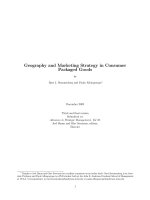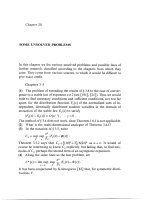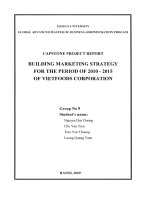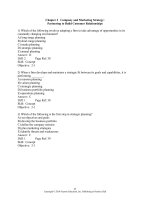Consumer behavior and marketing strategy 12e hawkins motherbaugh chapter 20
Bạn đang xem bản rút gọn của tài liệu. Xem và tải ngay bản đầy đủ của tài liệu tại đây (2.47 MB, 25 trang )
CHAPTER
20
Marketing Regulation
and Consumer Behavior
McGraw-Hill/Irwin
Copyright © 2013 by The McGraw-Hill Companies, Inc. All rights reserved.
PART VI: CONSUMER BEHAVIOR AND MARKETING REGULATION
20-2
Learning Objectives
Explain the two major concerns in marketing to children that CARU deals with
L01
L01
Describe the various marketing activities aimed at children that are controversial
L02
L02
Discuss new guidelines by the FTC regarding online privacy protection for adults
L03
L03
Explain marketing communication issues related to adults including deceptive advertising
L04
L04
Discuss regulation concerns when marketing to adults as they relate to product and price
L05
L05
20-3
Consumer Behavior In The News…
Legal or Not? – You Be the Judge.
McDonald’s sponsored report cards in an elementary school. Here’s how it worked…
McDonald’s paid for the printing and in return
Put their logo on the report card and offered a free Happy Meal for good grades or
attendance.
Source: E. B. York, “McDonald’s Discontinues Report-Card Sponsorship,” Advertising Age, January 21, 2008, p. 37.
20-4
Consumer Behavior In The News…
Legal or Not? – You Be the Judge.
If you said it is LEGAL you are correct! However, legality is only one factor.
The school received complaints and bad PR after a parent contacted the
Campaign for a Commercial Free Childhood.
McDonald’s retracted the sponsorship and paid for reprinting.
The Irony? The school approached McDonald’s about the sponsorship!
Source: E. B. York, “McDonald’s Discontinues Report-Card Sponsorship,” Advertising Age, January 21, 2008, p. 37.
20-5
Regulation and Marketing to Children
CARU – Industry Self-Regulation
Concerns about the Ability of Children to Comprehend Commercial Messages
Concerns about the Effects of the Content of Commercial Messages on Children
Controversial Marketing Activities Aimed at Children
Children’s Online Privacy Issues
20-6
Regulation and Marketing to Children
Self-Regulatory Body
The National Advertising Division of the Council of Better Business Bureaus is the primary self-regulatory body
of the American advertising industry.
The Children’s Advertising Review Unit (CARU) is a special unit created by this body to review
advertising aimed at children.
McDonald’s Happy Meal Commercial
YouTube Spotlight
20-7
Regulation and Marketing to Children
Comprehension Concerns
Two Major Issues Relating to Comprehension:
Do Children Understand the Selling Intent of Commercials?
Can Children Understand the Words and Phrases in Commercials?
20-8
Regulation and Marketing to Children
20-9
Regulation and Marketing to Children
Concerns about the Effects of the Content of Commercial Messages on Children
Health and Safety
Values
CARU Guidelines
20-10
Regulation and Marketing to Children
20-11
Regulation and Marketing to Children
Controversial Marketing Activities Aimed at Children
Mobile Marketing and Children
Commercialization of Schools
Internet Marketing and Children
20-12
Regulation and Marketing to Children
Mobile Marketing and Children
Sometimes referred to as the “Third Screen,” cell phones are an increasingly integral part of our lives.
Marketers see younger children as the next big growth market.
Mobile Marketing Efforts
•
•
•
•
ringtones
mobile games
text-in contests
mobile advertising
20-13
Regulation and Marketing to Children
Commercialization of Schools
There has been ongoing concern and controversy around the commercialization of elementary and high
schools.
The following are commercialization activities as classified by the Consumers Union:
In-school Ads
Ads in Classroom
Corporate-sponsored Educational Materials and Programs
Corporate-sponsored Contests and Incentives Programs
20-14
Regulation and Marketing to Children
Internet Marketing and Children
Children are major users of the Internet, and marketers use the Internet to communicate with kids.
Two major concerns have emerged:
1.
Invading children’s privacy
2.
Exploitation of children through manipulative sales
techniques, e.g., adver-games.
20-15
Regulation and Marketing to Children
Children’s Online Privacy Issues
Children’s Online Privacy Protection Act (COPPA)
Online privacy relates to collection and use of information from
websites
COPPA passed by Congress in 1998
FTC issued Children’s Online Privacy Protection Rule (a.k.a.
The Rule) in 1999
20-16
Regulation and Marketing to Children
20-17
Applications in Consumer Behavior
Education is a key aspect of the
FTC’s fight against online
privacy invasion among
children
Source: .
20-18
Regulation and Marketing to Adults
Consumer Privacy
Marketing Communications
Product Issues
Pricing Issues
20-19
Video Application
The following Video Clip demonstrates the importance of regulatory
and ethical element considerations within the context of the marketing
environment.
20-20
20-21
20-21
Regulation and Marketing to Adults
20-22
Regulation and Marketing to Adults
Marketing Communications
Advertising and Values
Consumer Information Accuracy
Adequacy of Consumer Information
20-23
Regulation and Marketing to Adults
Information Accuracy and Deception
Deception can occur even though a direct false claim has not been made
Direct claim
Logical implication
Pragmatic implication
Firms can be held liable for false logical and pragmatic implications they create
Example: Weedex fights weeds – many would understand “fight” to mean “kill”
If Weedex does not kill weeds, then the pragmatic implication (fight = kill) would be false
20-24
Applications in Consumer Behavior
Adequacy of Consumer Information
FDA label rule deals with trans fats.
Provide opportunities for some food marketers and challenges for
others.
Weetabix can use trans fats as a point of differentiation.
20-25









